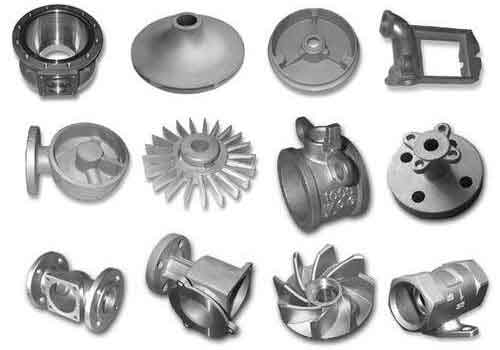Residual stress in sand casting parts significantly impacts dimensional accuracy, machining quality, and service performance. This study investigates the residual stress distribution in GGV30 vermicular graphite iron (VGI) clutch pressure plates through numerical simulations and experimental measurements. A multi-field coupling approach combining thermal-stress analysis was implemented using ProCAST to optimize sand casting processes and minimize residual stress.
1. Numerical Simulation of Sand Casting Process
The pressure plate geometry was modeled in UG NX, and the sand mold assembly was reconstructed based on industrial resin sand casting parameters. Key process variables included:
- Pouring temperature: 1,419°C
- Mold initial temperature: 25°C
- Filling time: 7.5 s
Thermophysical properties of VGI were calculated using the Lever rule:
$$ \rho(T) = 7200 – 0.8T \quad (\text{kg/m}^3) $$
$$ k(T) = 28 + 0.02T \quad (\text{W/(m·K)}) $$

2. Stress Formation Mechanism
The residual stress in sand casting parts originates from three-phase interactions:
| Stress Type | Generation Mechanism | Contribution |
|---|---|---|
| Thermal Stress | Uneven cooling rates between thick/thin sections | 65-75% |
| Phase Transformation Stress | Volume changes during eutectoid reaction | 15-20% |
| Shrinkage Stress | Mold restraint during solidification | 10-15% |
The radial stress distribution follows:
$$ \sigma_r(r) = \frac{E\alpha}{1-\nu} \left[ \frac{1}{r^2} \int_0^r T(r’)r’dr’ – T(r) \right] $$
where \( E \) = 150 GPa, \( \nu \) = 0.28, \( \alpha \) = 12×10⁻⁶/°C.
3. Process Optimization for Sand Casting Parts
Four strategies were evaluated for residual stress reduction:
3.1 Chemical Composition Adjustment
Increasing carbon equivalent (CE) from 4.32% to 4.64% reduced stress by 18.9%:
| CE (%) | Si/C Ratio | Residual Stress (MPa) |
|---|---|---|
| 4.32 | 0.65 | 82.3 |
| 4.64 | 0.73 | 66.7 |
3.2 Thermal Parameter Optimization
Lower shakeout temperature (<300°C) decreased residual stress by 12.4% compared to 500°C shakeout.
3.3 Gating System Redesign
The bottom-gating system reduced maximum stress from 89.3 MPa to 56.8 MPa through improved thermal uniformity.
4. Experimental Validation
Blind-hole drilling measurements confirmed simulation accuracy with <9% deviation:
| Location | Simulation (MPa) | Experiment (MPa) |
|---|---|---|
| Inner Rim | 68.3 | -73.0 |
| Web Section | 48.0 | -50.5 |
The stress measurement principle follows:
$$ \sigma_1 = \frac{E}{2(1+\nu)} \left( \frac{\epsilon_0 + \epsilon_{90}}{A} + \frac{\epsilon_0 – \epsilon_{90}}{B} \right) $$
$$ A = -0.0725, \quad B = -0.2185 $$
5. Industrial Implementation
Optimized parameters for sand casting parts production:
- Natural aging duration: Reduced from 15 to 10 days
- Recommended CE: 4.64% with Si/C=0.73
- Pouring temperature: 1,380-1,420°C
This comprehensive approach enables production of low-stress sand casting parts with improved dimensional stability, achieving <0.1 mm/m flatness deviation in clutch pressure plates.
